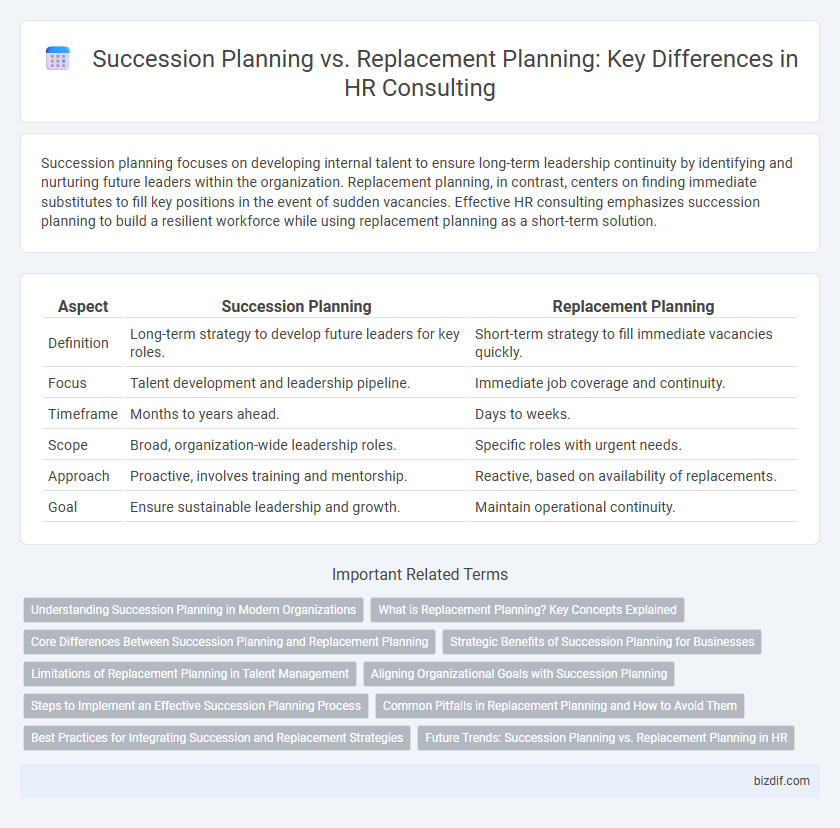Succession planning focuses on developing internal talent to ensure long-term leadership continuity by identifying and nurturing future leaders within the organization. Replacement planning, in contrast, centers on finding immediate substitutes to fill key positions in the event of sudden vacancies. Effective HR consulting emphasizes succession planning to build a resilient workforce while using replacement planning as a short-term solution.
Table of Comparison
| Aspect | Succession Planning | Replacement Planning |
|---|---|---|
| Definition | Long-term strategy to develop future leaders for key roles. | Short-term strategy to fill immediate vacancies quickly. |
| Focus | Talent development and leadership pipeline. | Immediate job coverage and continuity. |
| Timeframe | Months to years ahead. | Days to weeks. |
| Scope | Broad, organization-wide leadership roles. | Specific roles with urgent needs. |
| Approach | Proactive, involves training and mentorship. | Reactive, based on availability of replacements. |
| Goal | Ensure sustainable leadership and growth. | Maintain operational continuity. |
Understanding Succession Planning in Modern Organizations
Succession planning in modern organizations involves identifying and developing internal talent to fill key leadership roles over time, ensuring business continuity and long-term growth. This strategic process focuses on nurturing high-potential employees through targeted training, mentorship, and career development initiatives. Unlike replacement planning, which addresses immediate vacancies, succession planning aligns workforce development with organizational goals and future challenges.
What is Replacement Planning? Key Concepts Explained
Replacement planning involves identifying and preparing internal candidates to fill specific roles immediately when vacancies arise, ensuring business continuity. It focuses on short-term needs by pinpointing ready-now successors for critical positions based on current skills and experience. Key concepts include talent inventory, readiness assessment, and gap analysis to address sudden departures effectively.
Core Differences Between Succession Planning and Replacement Planning
Succession planning focuses on long-term leadership development by identifying and nurturing high-potential employees to fill future critical roles, ensuring organizational continuity and growth. Replacement planning addresses immediate needs by pinpointing specific candidates ready to step into key positions upon sudden vacancies, often with less emphasis on development. The core difference lies in succession planning's strategic, proactive talent pipeline creation versus replacement planning's reactive, position-specific focus.
Strategic Benefits of Succession Planning for Businesses
Succession planning offers strategic benefits by ensuring leadership continuity and minimizing operational disruptions during transitions, which replacement planning often overlooks. It fosters internal talent development, aligning potential leaders with long-term business goals to enhance organizational resilience and competitive advantage. Businesses leveraging succession planning experience improved employee engagement and retention by demonstrating commitment to career growth and leadership opportunities.
Limitations of Replacement Planning in Talent Management
Replacement planning in talent management often overlooks the development of future leaders by focusing solely on immediate vacancies, leading to a reactive approach that limits strategic growth. It tends to prioritize short-term fixes rather than cultivating a diverse pipeline of high-potential candidates, reducing organizational agility and resilience. This narrow focus can result in skill gaps and insufficient readiness for evolving business challenges, hindering long-term succession success.
Aligning Organizational Goals with Succession Planning
Succession planning strategically aligns talent development with long-term organizational goals by identifying and preparing future leaders to drive business continuity and growth. Unlike replacement planning, which focuses solely on filling immediate vacancies, succession planning integrates leadership development with company vision and workforce needs. This proactive approach ensures that critical roles are filled by capable employees who understand and support the organization's strategic priorities.
Steps to Implement an Effective Succession Planning Process
Identify key roles critical to organizational success and assess potential internal candidates based on performance, skills, and leadership capabilities. Develop personalized development plans including mentorship, training, and stretch assignments to prepare candidates for future leadership roles. Regularly review and update the succession plan to reflect changes in business strategy, employee progress, and workforce dynamics ensuring readiness for smooth leadership transitions.
Common Pitfalls in Replacement Planning and How to Avoid Them
Replacement planning often falls short due to its narrow focus on immediate vacancies rather than long-term organizational growth, leading to talent gaps and limited leadership development. Common pitfalls include overlooking employee potential, neglecting diverse skill sets, and failing to align plans with strategic goals. Avoid these issues by adopting a dynamic succession planning approach that integrates regular talent assessments, cross-functional training, and clear career pathing aligned with future business needs.
Best Practices for Integrating Succession and Replacement Strategies
Effective succession planning involves identifying and developing internal talent to fill key leadership roles, while replacement planning focuses on quickly filling vacancies with ready-now candidates. Best practices for integrating these strategies include aligning them with organizational goals, conducting comprehensive talent assessments, and creating development plans that prepare high-potential employees for future responsibilities. Leveraging data-driven insights ensures seamless transitions and minimizes disruptions within the workforce.
Future Trends: Succession Planning vs. Replacement Planning in HR
Succession planning increasingly leverages predictive analytics and AI-driven talent assessments to identify and develop high-potential employees for future leadership roles, contrasting with replacement planning's traditional focus on filling immediate vacancies. Future trends emphasize continuous talent pipeline development and strategic workforce planning over reactive position coverage, aligning HR practices with organizational agility and long-term growth. Enhanced data integration and real-time performance tracking empower HR professionals to create dynamic succession plans tailored to evolving business needs.
Succession Planning vs Replacement Planning Infographic

 bizdif.com
bizdif.com